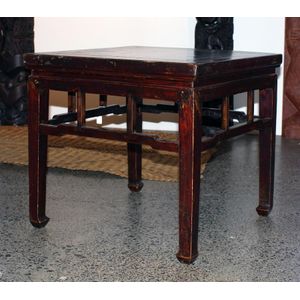Fretwork Gallery Table with Fluted Legs
You must be a subscriber, and be logged in to view price and dealer details.
Subscribe Now to view actual auction price for this item
When you subscribe, you have the option of setting the currency in which to display prices to $Au, $US, $NZ or Stg.
- Gallery - On furniture, a gallery is a small upright section, frequently pierced and decorated, around the tops of small items of furniture, such as davenports, side tables, and so forth. Galleries are made in brass or bronze,and be fretted, pierced or solid timber. A three-quarter gallery is one that surrounds three of the four sides of a table, desk or other top.
- Fluting - A form of decoration found on many pieces of furniture, as well as ceramics, silver and clocks, in which round-bottomed grooves, of varying width and depth, are let into columns, pilasters, legs. As a general rule, flutes are cut in the vertical, though they may follow a turned leg in a spiral pattern. In cross-section, they may be described as a series of 'U' shapes, rising and narrowing at each end of the groove. Fluting is the opposite of reeding, with which fluting is often associated.
- Tapered Legs - found on both cabinet and country-made furniture from the 18th to the later 19th centuries. The leg sometimes terminates in a spade foot, though on most country furniture the taper continues for the whole length of the leg. The important thing to remember is that the taper ought only to be on the inside face of the leg, and the outer face should be straight and square. Some legs were made where both sides tapered, but in such a case the taper ought to be the same on both the inner and outer faces of the leg. Where the inside of a leg is straight, with only the outer face tapering, there is every reason to be suspicious
- Fretwork - Pierced intricate decorative patterns, cut with a fine saw and generally found around the galleries of desk tops, open-hanging shelves and small tables.
In open fret, the timber is completely pierced, giving an appearance of great lightness and delicacy.
With blind fret, as seen in Chinoiserie styles of Chippendale, the fretwork is applied like a moulding to a solid panel.
This item has been included into following indexes:
Visually similar items

Chinese hardwood side table. Carved panels of figures among pavilions & pine trees to sides & to face of sliding drawer. Dense dark-stained wood. Height 58 cm. Width 43 cm diameter 35 cm

A Charles I oak credence table, English, circa 1640, of octagonal outline with curved fluted apron on slender baluster turned legs United with platform base, 84 cm width. Provenance: By Repute purchased from Henry Woods Wilson 1966.

Pair of Chinese hardwood side tables. Width 57 cm

A George III style tray table, English, 19th century. 47 cm high, 63 cm wide, 47 cm wide
